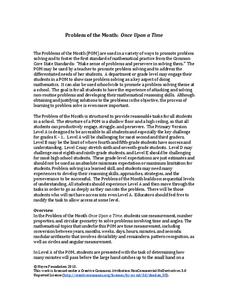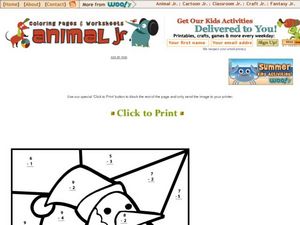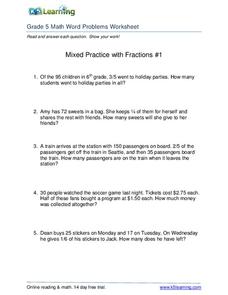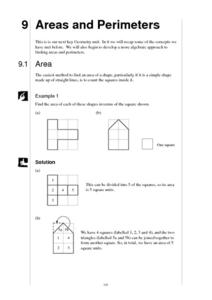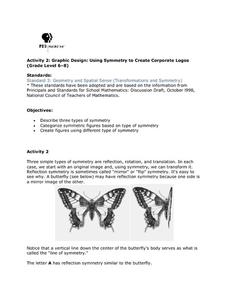Savvas Learning
A Picture Tells . . . Three Facts
Elementary schoolers evaluate a set of shapes in which some are shaded and some are not. They then write three multiplication sentences for each group of shapes that tells the number that are shaded, not shaded, and total. There are...
Curated OER
Interesting Integers
Upper elementary and middle schoolers practice solving addition and multiplication problems with positive and negative numbers. They use a number line initially to help find a solution.
Super Teacher Worksheets
Measuring With a Ruler
When it comes to using a ruler, how does your class measure up? Find out with this simple measurement worksheet that asks children to determine the lengths of common, everyday items to the nearest half inch.
Student Puzzles
Primary Long Division
Dividing large numbers can be a long and frustrating process for young mathematicians, but after completing these skills practice worksheets they'll be masters of long division.
Noyce Foundation
Time to Get Clean
It's assessment time! Determine your young mathematicians' understanding of elapsed time with this brief, five-question quiz.
Noyce Foundation
Sewing
Sew up your unit on operations with decimals using this assessment task. Young mathematicians use given rules to determine the amount of fabric they need to sew a pair of pants. They must also fill in a partially complete bill for...
Inside Mathematics
Archery
Put the better archer in a box. The performance task has pupils compare the performance of two archers using box-and-whisker plots. The resource includes sample responses that are useful in comparing individuals' work to others.
Noyce Foundation
The Shape of Things
Investigate the attributes of polygons. A thorough set of lessons presents problem scenarios for elementary through high school classes. The first lessons focus on basic characteristics of polygons, including the line of symmetry. As the...
Noyce Foundation
Once Upon a Time
Examine the relationship between time and geometry. A series of five lessons provides a grade-appropriate problem from elementary through high school. Each problem asks learners to compare the movement of the hands on a clock to an angle...
Noyce Foundation
Miles of Tiles
Create number sentences and equations to solve geometric problems. Each activity in the series of five asks young mathematicians to consider different-sized tiles to build structures according to specific criteria. The first activities,...
Berkshire Museum
Adopt a Schoolyard Tree
Help young scientists connect with nature and learn about trees with a fun life science lesson. Heading out into the school yard, children choose a tree to adopt, taking measurements, writing descriptions, and drawing sketches of it in...
Lied Center of Kansas
The Ugly Duckling and The Tortoise and the Hare
Both The Ugly Duckling and The Tortoise and the Hare are great additions to an elementary language arts lesson. Young readers focus on the literary elements of each story, including characters and plot development, and apply counting and...
K5 Learning
The Astronomy Project
A passage about an astronomy lesson may leave readers starstruck. Fifth graders read about a class's exploration into the makeup of the galaxy and its constellations before answering six questions about the terms and vocabulary words...
K5 Learning
Queen Hulda and the Flax
Choosing humility over outstanding wealth can be beneficial in the long run. Elementary pupils practice reading comprehension with a short fairy tale about Queen Hulda and her gifts to a poor shepherd, and demonstrate their ability to...
Curated OER
Place Value
Providing a short review of place value, this activity focusing on numbers in the hundreds, could be used in a lower elementary classroom. This eight question worksheet could be a quick and easy way to have students practice this skill.
Curated OER
Differences Are Keys For Coloring
In this math worksheet, students solve subtraction problems and match the differences to color words to complete a picture. Students solve twenty problems to color the picture.
Curated OER
Total English Elementary: The Best Thing is...
Given two nouns separated by an adjective, learners create eight sentences using the adjective in comparative form. Example: Jamaica/hot/UK, which becomes Jamaica is hotter than the UK. They then write the superlative form of eight...
Curated OER
How Much Do I Watch TV?
In this television watching worksheet, students determine the amount of television they watch in a week by recording the names and times of the shows. They total the number of hours of watching time. You can use this with upper...
K5 Learning
Mixed Practice with Fractions
Help young mathematicians see how fractions are used every day in the world around them with a series of problem solving exercises. Offering eight different word problems, this instructional activity challenges children to apply their...
Missouri Department of Insurance
Health Insurance
Confused by how health insurance works? This informational pamphlet and worksheet from the Missouri Department of Insurance offers explanations and examples to help future adults make important decisions regarding health insurance.
Centre for Innovation in Mamatics Teaching
Areas and Perimeters
Cover some serious area in your geometry curriculum with this collection of worksheets. After first introducing the concept of area using the tiling method, this resource continues on to teach learners how to use the area and perimeter...
Super Teacher Worksheets
Improper Fractions & Mixed Numbers
Young mathematicians demonstrate their understanding of part-whole relationships in a fraction skills instructional activity. Presented with a series of mixed numbers and improper fractions, learners must correctly convert each of them...
Super Teacher Worksheets
Number Patterns
Pattern recognition is an essential step in the development of young mathematicians fluency with the four basic operations. This simple skills practice worksheet asks children identify and complete three different numerical patterns,...
PBS
Using Symmetry to Create Corporate Logos
Young mathematicians investigate the use of symmetry in graphic design. After first learning about reflection, translational, and rotational symmetry, children use this new knowledge to identify symmetry in letters of the alphabet and...










